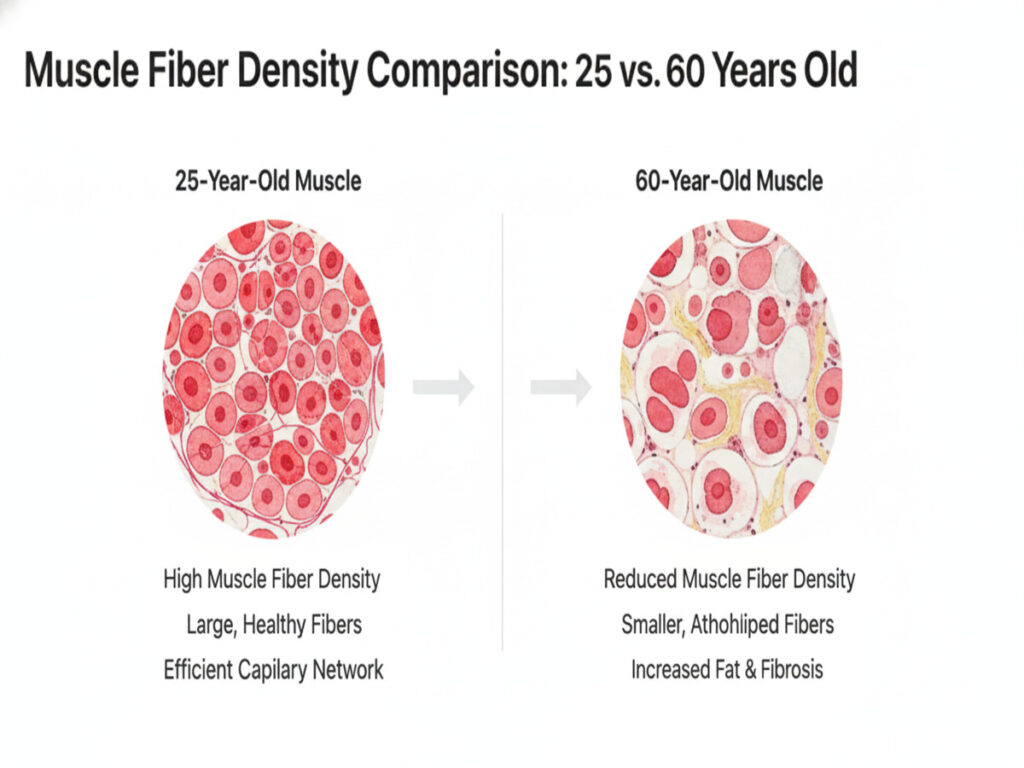Introduction: The New Fitness Priority After 40
After age 40, maintaining muscle is no longer just about looking strong — it’s about preserving vitality, independence, and metabolic health. Muscle loss, known as sarcopenia, is a natural part of aging, but modern science shows it’s largely preventable.
In the U.S., research indicates that adults lose 3–8% of muscle mass per decade after age 30, accelerating past 40. This loss leads to slower metabolism, reduced balance, lower energy, and higher risk of chronic disease. The good news? With targeted strength, nutrition, and recovery strategies, you can reverse the trend and rebuild lean muscle at any age.

Understanding Sarcopenia and Muscle Decline
Sarcopenia refers to age-related muscle degeneration caused by reduced physical activity, hormonal changes, and inadequate protein intake. Over time, it leads to:
- Decreased strength and endurance
- Poor posture and joint instability
- Higher risk of falls and fractures
- Slower metabolism and weight gain
According to the National Institute on Aging, sarcopenia affects 1 in 3 adults over 50 in the U.S. but can be slowed—or even reversed—with the right interventions.
Why Muscle Loss Accelerates After 40
After 40, several biological and lifestyle factors accelerate muscle decline:
| Factor | Effect |
|---|---|
| Lower Testosterone & Growth Hormone | Reduces protein synthesis and muscle recovery. |
| Decreased Physical Activity | Sedentary lifestyle weakens muscle fibers. |
| Poor Nutrition | Insufficient protein and micronutrients slow muscle repair. |
| Insulin Resistance | Reduces muscle’s ability to use nutrients effectively. |
| Chronic Stress & Lack of Sleep | Elevates cortisol, leading to muscle breakdown. |
Statistic: A Harvard Health review found that resistance training can reduce age-related muscle loss by up to 50% in older adults who train regularly.

The Science of Muscle Maintenance and Growth
Muscle growth is driven by muscle protein synthesis (MPS) — the process of repairing and building new fibers after exercise.
For adults over 40, MPS is less efficient, requiring higher protein intake, mechanical tension (from strength training), and adequate recovery.
Key scientific principles:
- Progressive overload — Gradually increasing resistance stimulates continued growth.
- Protein timing — Consuming high-quality protein every 3–4 hours maximizes synthesis.
- Recovery cycles — Muscles grow during rest, not during workouts.
Expert quote:
“Muscle is the organ of longevity. Maintaining it through resistance training and protein nutrition is the single most effective anti-aging strategy.”
— Dr. Gabriella Torres, MD, Longevity Research Institute
Key Strength Training Principles for Aging Muscles
1. Prioritize Compound Movements
Include exercises that engage multiple muscles: squats, deadlifts, pushups, and rows. These build full-body strength and stability.
2. Train at Moderate to High Intensity
Focus on 70–85% of your 1-rep max (6–12 reps per set). This intensity promotes hypertrophy without joint strain.
3. Incorporate Resistance Bands and Free Weights
These improve balance, coordination, and range of motion — vital for longevity.
4. Add Power Movements
Incorporate controlled plyometrics or quick lifts once a week to preserve fast-twitch fibers, which decline fastest with age.
5. Recovery Days Are Training Days
Include mobility work, stretching, and low-intensity cardio (like walking or swimming) for circulation and joint support.
Nutritional Foundations for Muscle Preservation
Protein: The Prime Nutrient
Adults over 40 should aim for 1.0–1.4 g of protein per pound of body weight daily.
Best sources: chicken, fish, eggs, Greek yogurt, legumes, and whey protein.
Micronutrients Matter
- Vitamin D: Enhances muscle strength and testosterone levels.
- Magnesium: Aids in recovery and reduces cramps.
- Omega-3s: Improve muscle protein synthesis and joint function.
Smart Carbs and Fats
Carbs fuel workouts; healthy fats (avocados, olive oil, nuts) balance hormones and support longevity.
Hydration for Muscle Function
Dehydration impairs muscle performance. Aim for 2.5–3 liters of water daily.
Actionable Lifestyle Strategies
- Get at least 7 hours of sleep to boost recovery and hormone balance.
- Reduce alcohol and sugar — both accelerate muscle breakdown.
- Manage stress through yoga, meditation, or breathwork.
- Include walking or cycling for circulation and recovery.
- Schedule annual hormone checks (testosterone, estrogen, thyroid).
Practical Muscle Maintenance Checklist
☑ Strength train 3–4 times weekly
☑ Eat 25–30g of protein per meal
☑ Supplement vitamin D and omega-3s
☑ Get 7–8 hours of sleep
☑ Stay hydrated daily
☑ Stretch or walk on rest days
☑ Limit processed carbs and alcohol
Muscle-Friendly Foods Table
| Food | Nutrients | Muscle Benefit |
|---|---|---|
| Eggs | Protein, leucine | Boosts muscle protein synthesis |
| Salmon | Omega-3s | Reduces inflammation and muscle loss |
| Lentils | Plant protein, iron | Improves recovery and energy |
| Greek Yogurt | Calcium, probiotics | Enhances digestion and muscle repair |
| Spinach | Magnesium, antioxidants | Supports recovery and reduces fatigue |
| Chicken Breast | Lean protein | Promotes muscle repair |
| Almonds | Healthy fats, Vitamin E | Supports hormone balance |

Expert Insights on Sarcopenia Prevention
“Muscle decline after 40 is not inevitable — it’s a consequence of inaction. Train smart, eat consistently, and your 50s can outperform your 30s.”
— Dr. David Klein, Exercise Physiologist, UCLA
“Resistance training and protein-rich diets are the closest things we have to a fountain of youth.”
— Dr. Emma Raynor, Functional Nutrition Specialist
Common Myths & FAQ
Q1: Can I really build muscle after 40?
A: Yes. With proper strength training and nutrition, muscle growth remains highly achievable well into your 60s.
Q2: Do I need supplements?
A: Focus on whole foods first; consider creatine, whey protein, and vitamin D for added support.
Q3: Should I avoid heavy weights?
A: No. When done with proper form, moderate to heavy lifting strengthens bones and joints safely.
Q4: How fast can I see results?
A: Noticeable strength gains appear within 6–8 weeks with consistency.
Authoritative Resources
- National Institute on Aging – Preventing Muscle Loss
- Harvard Health – Strength Training After 40
- American College of Sports Medicine – Exercise Guidelines for Older Adults
Internal Reading Links (Fitoast Articles)
- The Ultimate Beginner’s Guide to Intermittent Fasting 16:8 with Meal Plans
- The New Frontier of Nutrigenomics: Personalized Diets for Americans
Conclusion & Call-to-Action
Muscle loss after 40 isn’t destiny — it’s a signal to train smarter, eat cleaner, and recover better. Every rep, every meal, and every good night’s sleep adds to your long-term strength bank.
Next Step: Start resistance training today, track your protein intake, and focus on progressive overload. Within months, you’ll not only feel stronger — you’ll move, think, and age better.

